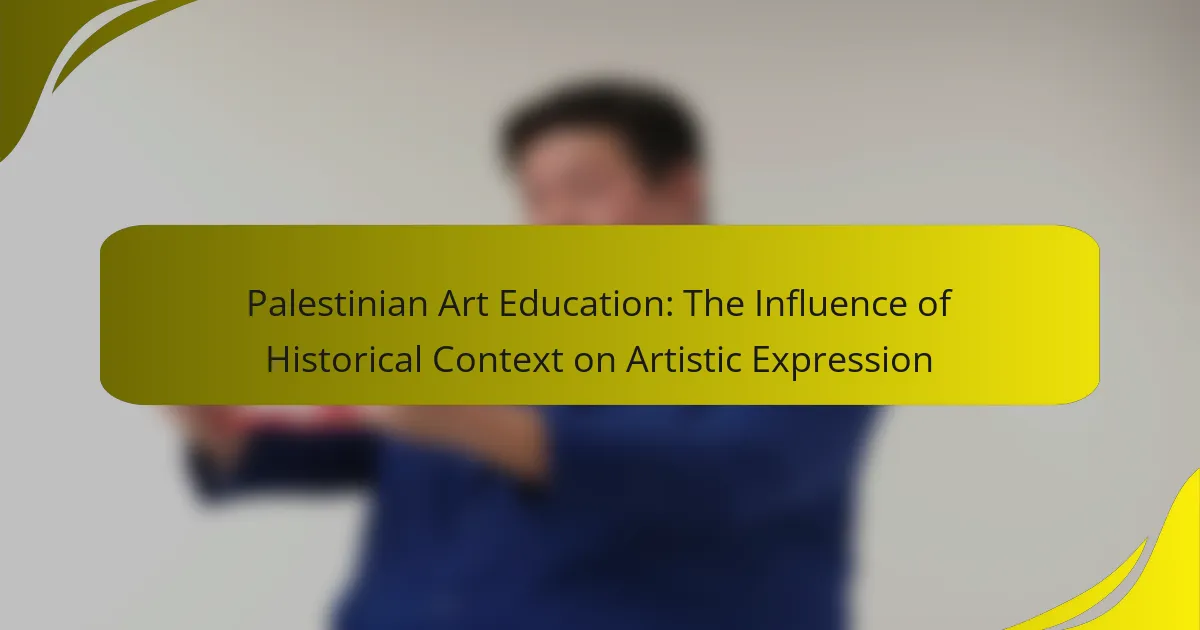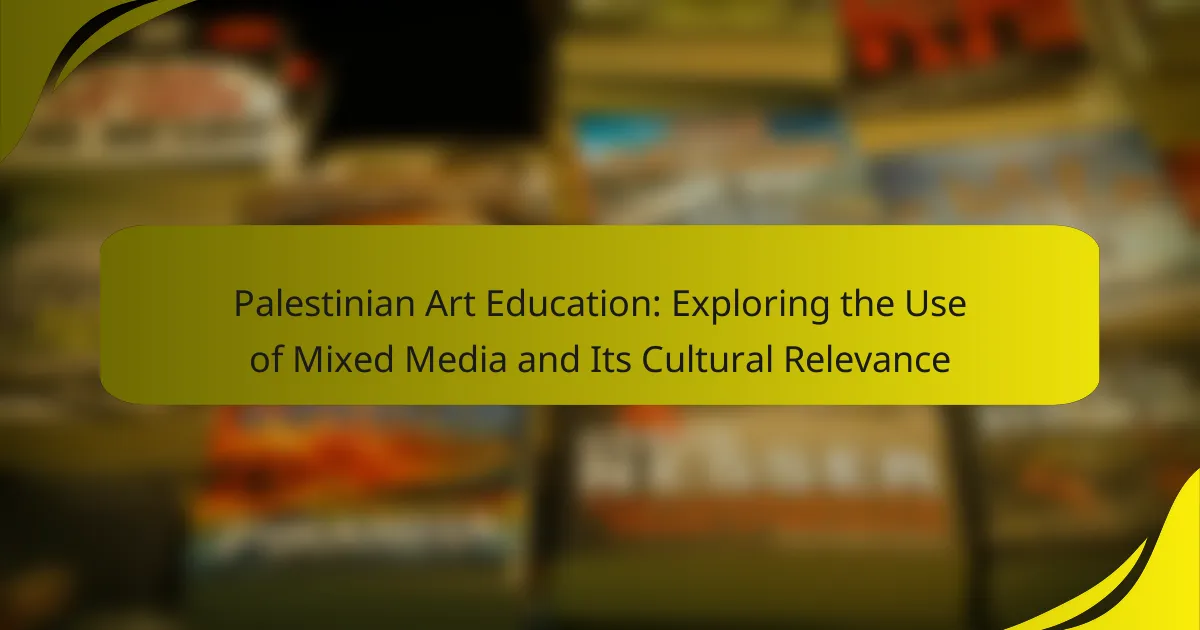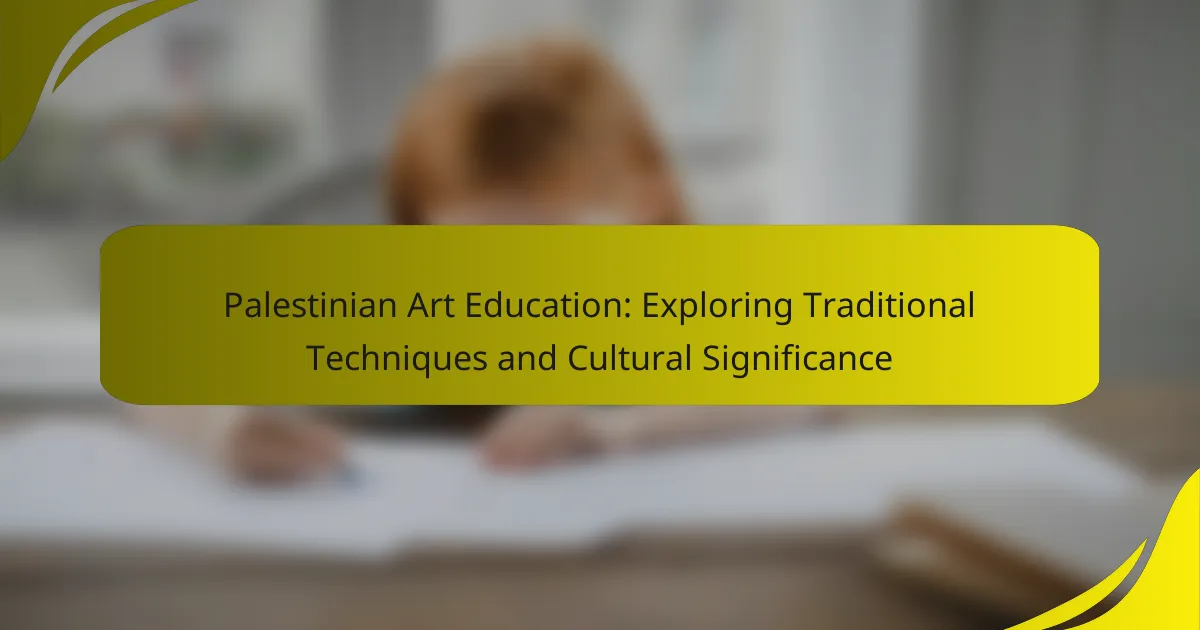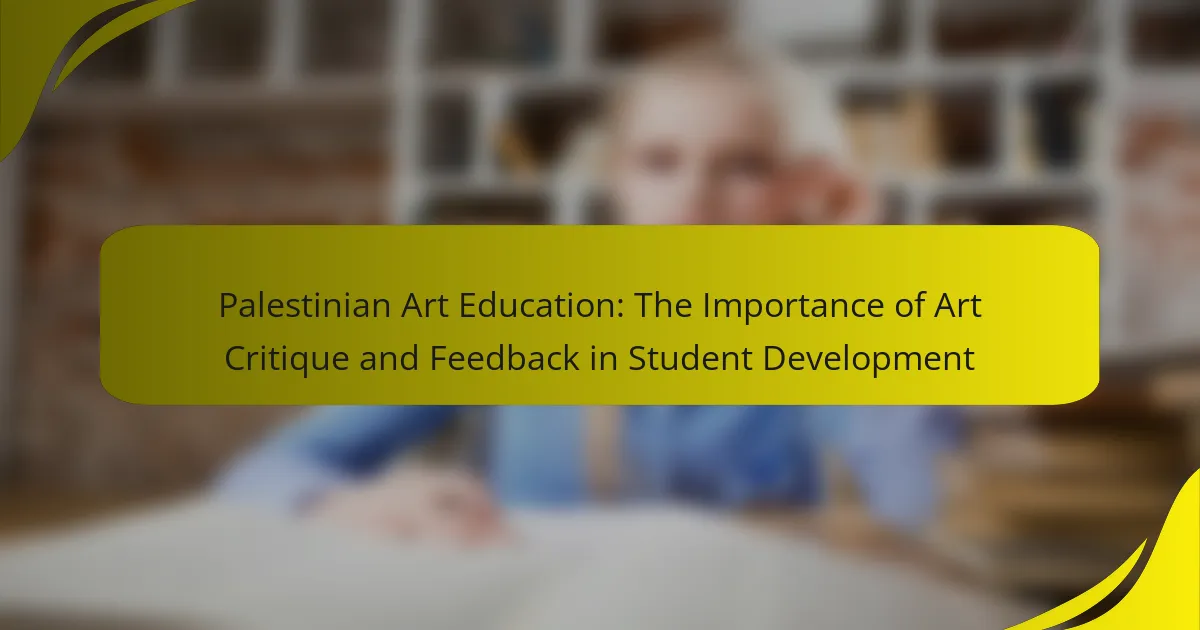Palestinian Art Education is a framework designed to teach artistic skills while reflecting the cultural and societal context of Palestine. This educational system combines traditional and contemporary art forms, addressing significant themes such as identity, resistance, and community. Key methods include hands-on workshops, collaborative projects, and the integration of digital tools, all aimed at fostering creativity and critical thinking among students. Challenges such as limited resources, political instability, and cultural restrictions impact the effectiveness of art education in Palestine, highlighting the need for supportive initiatives like mentorship programs and community engagement to enhance learning experiences and preserve cultural identity.
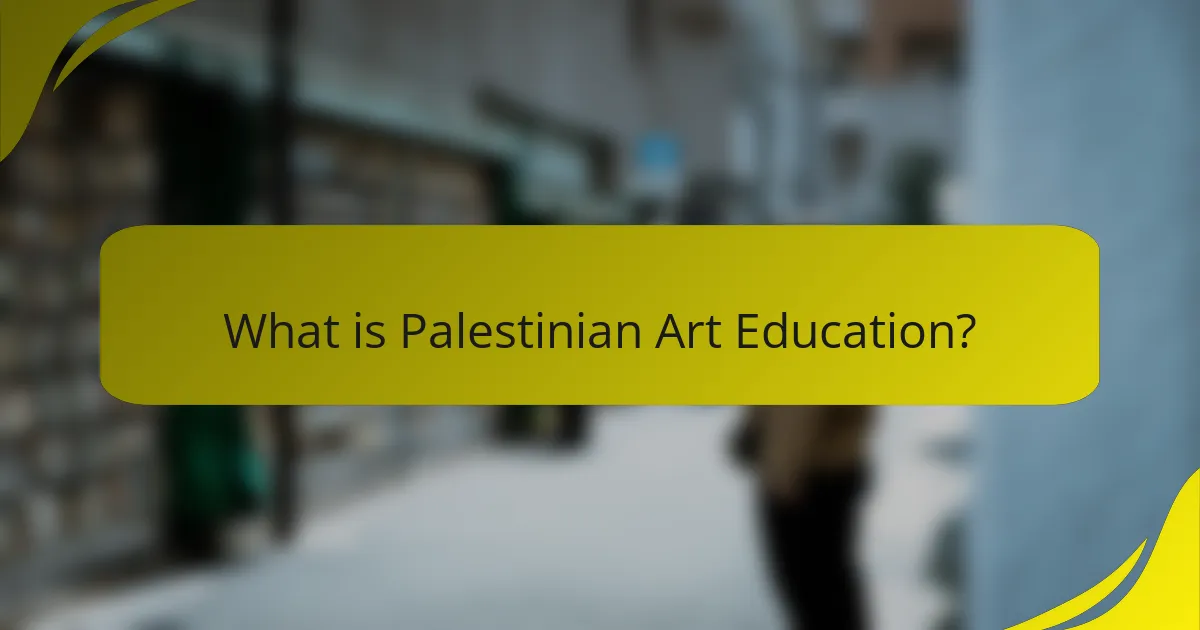
What is Palestinian Art Education?
Palestinian Art Education is a system of teaching artistic skills within the context of Palestinian culture and society. It encompasses various methods that aim to foster creativity and artistic expression among students. This educational framework is influenced by the unique historical and socio-political circumstances of Palestine. It integrates traditional and contemporary art forms, promoting both local heritage and modern artistic practices. Palestinian Art Education often addresses themes of identity, resistance, and community. Institutions like the International Academy of Art Palestine contribute to this educational landscape. They provide programs that nurture artistic talent and critical thinking. Such initiatives are vital for preserving cultural identity and fostering dialogue through art.
How does Palestinian Art Education integrate cultural identity?
Palestinian Art Education integrates cultural identity by emphasizing local traditions and narratives. It incorporates themes relevant to Palestinian history and social issues. Students engage with traditional art forms, such as embroidery and calligraphy. These practices foster a connection to their heritage. Art education also encourages critical discussions about identity and resistance. Workshops often include community involvement, reinforcing collective memory. This approach helps students express their cultural experiences through various artistic mediums. Research shows that such integration strengthens students’ sense of belonging and pride in their identity.
What are the key elements of cultural identity in Palestinian art?
The key elements of cultural identity in Palestinian art include historical narratives, symbolism, and community representation. Historical narratives reflect the struggles and resilience of the Palestinian people. Symbolism often incorporates traditional motifs, such as olive trees and the keffiyeh, which represent heritage and resistance. Community representation is crucial, as artists often depict local life, traditions, and social issues. These elements serve to maintain cultural continuity and express collective identity. Palestinian art frequently addresses themes of displacement and longing for homeland, reinforcing a shared cultural memory and identity.
How does cultural identity influence artistic expression in education?
Cultural identity significantly influences artistic expression in education by shaping the themes, techniques, and perspectives that students bring to their artwork. It affects how individuals interpret their surroundings and express their experiences. For instance, students from diverse cultural backgrounds may incorporate traditional motifs or narratives into their art. This incorporation reflects their heritage and personal histories. Research shows that art education that acknowledges and values cultural identity fosters greater engagement and creativity among students. A study by K. B. M. Al-Hadidi in “International Journal of Art & Design Education” highlights that culturally responsive teaching enhances students’ artistic skills and self-esteem. In this way, cultural identity serves as a vital component of artistic expression in educational settings.
Why is art education important in Palestinian contexts?
Art education is important in Palestinian contexts because it fosters cultural identity and resilience. It provides a means for self-expression amidst socio-political challenges. Art serves as a tool for community cohesion and healing. Educational programs in art encourage critical thinking and creativity. These skills are vital for personal and societal development. Research indicates that art education enhances academic performance across various subjects. In Palestinian schools, art can also address trauma and promote mental well-being. Overall, art education plays a crucial role in empowering individuals and communities in Palestine.
What role does art play in community building among Palestinians?
Art plays a crucial role in community building among Palestinians. It serves as a medium for expressing cultural identity and shared experiences. Art fosters social cohesion by bringing individuals together for collaborative projects. Community art initiatives often address social and political issues relevant to Palestinian life. These initiatives create safe spaces for dialogue and reflection. Artistic expressions, such as murals and performances, can raise awareness and inspire collective action. Moreover, art education programs empower youth and promote skill development. By engaging in art, Palestinians strengthen their community ties and resilience.
How does art education contribute to personal development for students?
Art education significantly contributes to personal development for students by enhancing creativity, critical thinking, and emotional expression. Engaging in artistic activities fosters innovative problem-solving skills. Students learn to interpret their emotions and experiences through various art forms. This process promotes self-awareness and confidence in their abilities. Research indicates that students involved in art education demonstrate improved academic performance across subjects. A study by Catterall (2002) found that students with high levels of arts engagement are more likely to excel in standardized tests. Furthermore, art education encourages collaboration and communication skills through group projects. Overall, art education plays a vital role in shaping well-rounded individuals.
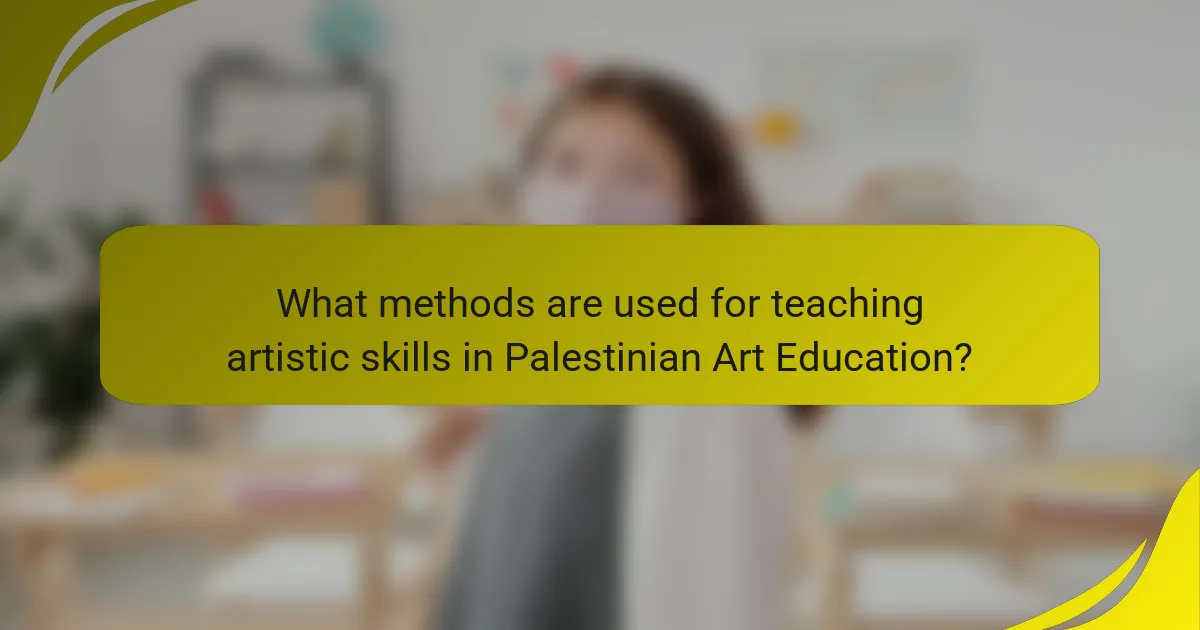
What methods are used for teaching artistic skills in Palestinian Art Education?
Palestinian Art Education employs various methods to teach artistic skills. These methods include hands-on workshops that promote practical experience. Additionally, collaborative projects encourage teamwork and creativity among students. Art history lessons provide context and inspiration for contemporary practices. Digital tools are increasingly integrated to enhance learning experiences. Community engagement fosters connections between artists and local culture. Mentorship programs link students with experienced artists for guidance. Finally, exhibitions showcase student work, validating their skills and efforts.
How do traditional methods shape art education in Palestine?
Traditional methods significantly shape art education in Palestine by incorporating cultural heritage and community practices. These methods emphasize the transmission of skills through direct observation and hands-on experience. Students learn traditional techniques such as calligraphy, pottery, and embroidery, which reflect Palestinian identity. Art education often includes storytelling and oral histories that connect students to their roots. Workshops led by local artisans enhance practical skills and cultural appreciation. This approach fosters a sense of belonging and continuity in artistic expression. Research shows that traditional art forms contribute to cultural resilience and identity preservation among Palestinian youth.
What are the characteristics of traditional Palestinian art techniques?
Traditional Palestinian art techniques are characterized by intricate geometric patterns, vibrant colors, and cultural symbolism. These techniques often include embroidery, pottery, and woodwork. Artists use natural dyes and materials, reflecting the region’s resources. The art frequently incorporates motifs from nature, such as plants and animals. Calligraphy is also a significant element, showcasing Arabic script’s beauty. Traditional methods are passed down through generations, preserving cultural heritage. Community involvement is essential, as art serves as a form of storytelling. These characteristics highlight the uniqueness and cultural significance of Palestinian artistic expression.
How are traditional methods adapted for modern education?
Traditional methods are adapted for modern education by integrating technology and contemporary practices. Educators blend traditional art techniques with digital tools. This combination enhances student engagement and accessibility. For instance, online platforms allow for collaborative projects across geographical barriers. Workshops may incorporate modern materials while retaining cultural significance. Additionally, traditional storytelling is used in conjunction with multimedia presentations. Research shows that this approach fosters creativity and critical thinking. Studies indicate that students perform better when traditional methods are contextualized within modern frameworks.
What innovative approaches are being implemented in Palestinian art education?
Innovative approaches in Palestinian art education include integrating technology and community engagement. Schools utilize digital platforms to enhance learning experiences. Virtual art galleries allow students to showcase their work globally. Collaborative projects with local artists foster cultural exchange. Art therapy programs address psychological needs in conflict-affected areas. Workshops emphasize traditional techniques alongside contemporary practices. These methods promote creativity and resilience among students.
How does technology influence art teaching methods in Palestine?
Technology significantly influences art teaching methods in Palestine by enhancing accessibility and engagement. Digital tools allow teachers to incorporate multimedia resources into lessons. This includes video tutorials, online galleries, and virtual art classes. Such resources help students explore diverse artistic styles and techniques. Furthermore, technology facilitates collaboration among students and educators across different regions. Online platforms enable sharing of artwork and feedback, fostering a community of learning. Research indicates that integrating technology in education increases student motivation and participation. A study conducted by the Palestinian Ministry of Education noted improved student outcomes in art subjects due to technology use.
What are the benefits of collaborative art projects in diverse environments?
Collaborative art projects in diverse environments foster creativity and enhance social cohesion. They encourage participants to share different perspectives and cultural backgrounds. This sharing leads to innovative ideas and solutions. Research shows that collaboration in art enhances communication skills. It also builds trust among participants. Additionally, these projects can improve community engagement. They often address social issues through artistic expression. Studies indicate that communities involved in collaborative art see increased social capital.
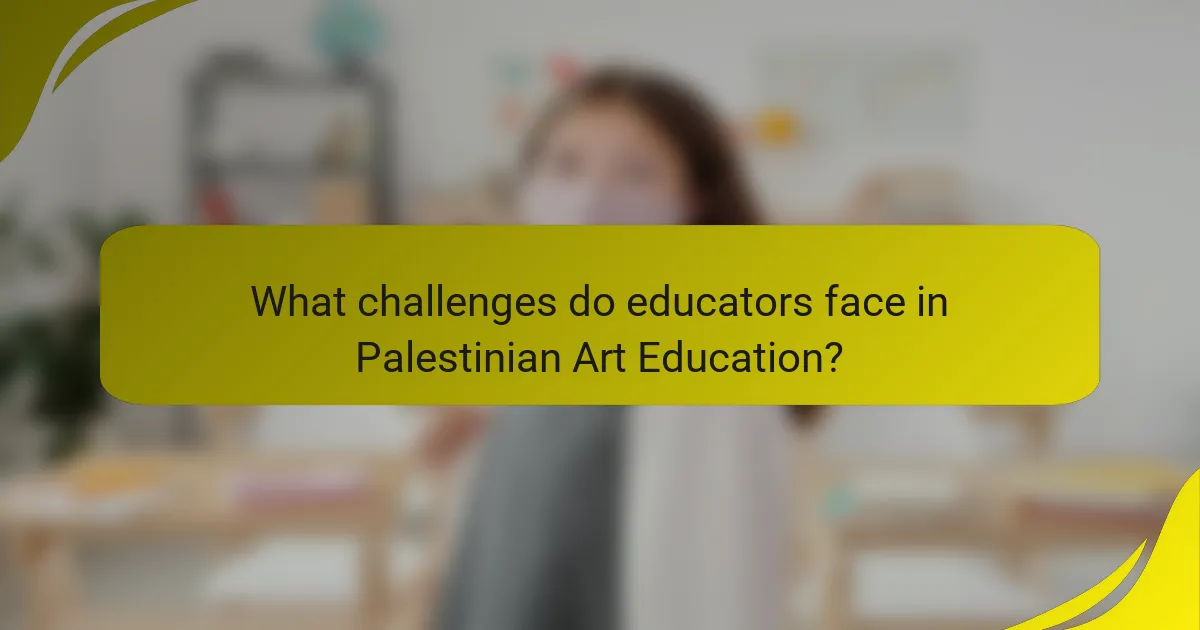
What challenges do educators face in Palestinian Art Education?
Educators in Palestinian Art Education face several challenges. Limited resources hinder access to materials and facilities. Political instability affects the learning environment and student participation. Cultural restrictions can limit the expression of artistic ideas. Additionally, inadequate training for teachers impacts the quality of instruction. These factors collectively create barriers to effective art education in Palestine.
How does political context affect art education in Palestine?
Political context significantly affects art education in Palestine. The ongoing conflict limits access to resources and facilities. Students often face restrictions on movement, impacting their ability to attend classes. The curriculum can be influenced by political ideologies, emphasizing certain narratives over others. Art educators may face censorship, limiting creative expression. Additionally, political instability can lead to a lack of funding for art programs. This environment shapes the themes and subjects that artists explore. Overall, the political landscape creates challenges for both students and educators in the field of art education in Palestine.
What are the barriers to accessing art resources and materials?
Barriers to accessing art resources and materials include economic constraints, limited availability, and political restrictions. Economic constraints often arise from the lack of funding for art programs. Many schools and communities cannot afford basic supplies. Limited availability refers to the scarcity of materials in local markets. This scarcity can hinder creativity and learning. Political restrictions may impact the importation of art supplies. For example, ongoing conflicts can disrupt supply chains. These barriers collectively restrict opportunities for artistic expression and education in Palestinian contexts.
How do educators navigate censorship and restrictions in their teaching?
Educators navigate censorship and restrictions in their teaching by employing creative strategies and adapting their curriculum. They often utilize alternative resources that align with educational goals while circumventing sensitive topics. Collaborative teaching methods can foster discussion and critical thinking without directly confronting restricted content. Educators may also engage in professional development to understand legal frameworks regarding censorship in their regions. For instance, they can attend workshops that focus on inclusive teaching practices. Additionally, building a supportive community among educators can provide a network for sharing resources and strategies. Research shows that teachers who collaborate on curriculum design can effectively address censorship while promoting artistic expression.
What strategies can be employed to overcome these challenges?
Employing collaborative learning strategies can effectively overcome challenges in Palestinian art education. Collaborative learning fosters peer interaction and shared knowledge. This approach encourages students to work together on artistic projects. It enhances creativity and problem-solving skills among participants. Additionally, integrating local cultural themes into the curriculum can make art education more relevant. This relevance increases student engagement and motivation. Utilizing technology in teaching can also address resource limitations. Digital tools can provide access to diverse artistic techniques and global art movements. Furthermore, professional development for educators can improve teaching methodologies. Training teachers in contemporary art education practices can enhance their effectiveness. These strategies collectively create a more inclusive and effective art education environment.
How can community engagement enhance art education initiatives?
Community engagement enhances art education initiatives by fostering collaboration between artists, educators, and local communities. This collaboration provides students with real-world experiences and diverse perspectives. Engaged communities can offer resources, such as venues for exhibitions and workshops. They can also facilitate partnerships that bring in professional artists as mentors. Research shows that programs involving community participation lead to increased student motivation and creativity. For example, studies indicate that students in community-based art programs demonstrate higher levels of artistic skill and critical thinking. Engaging the community also helps to create a supportive environment, where students feel valued and inspired. Therefore, community involvement is crucial for enriching art education initiatives.
What role do NGOs play in supporting art education in Palestine?
NGOs play a crucial role in supporting art education in Palestine. They provide funding for art programs and workshops in schools and communities. NGOs also facilitate training for local artists to enhance their teaching skills. They create platforms for young Palestinian artists to showcase their work. Additionally, NGOs help integrate art into the curriculum to foster creativity. They often collaborate with local institutions to expand resources and reach more students. Evidence shows that these initiatives increase access to art education in underprivileged areas. For instance, organizations like the A.M. Qattan Foundation have successfully implemented art education projects in various Palestinian regions.
What are some best practices for teaching artistic skills in diverse environments?
Best practices for teaching artistic skills in diverse environments include adapting teaching methods to cultural contexts. Understand the backgrounds of students to make lessons relevant. Incorporate various artistic traditions to engage different perspectives. Encourage collaboration among students to foster inclusivity. Use accessible materials that reflect the community’s resources. Provide constructive feedback that respects individual expression. Offer flexible lesson plans to accommodate varying skill levels. Create a safe space for experimentation to enhance creativity. These practices promote a richer learning experience and support diverse artistic expression.
How can educators foster inclusivity in art classrooms?
Educators can foster inclusivity in art classrooms by implementing diverse teaching strategies. They should incorporate various cultural perspectives in art lessons. This approach enhances students’ understanding of global art practices. Providing materials that reflect different backgrounds is essential. It allows all students to see themselves represented in their work. Group projects can encourage collaboration among students from diverse backgrounds. This interaction promotes understanding and respect for different viewpoints. Additionally, creating a safe space for expression is crucial. It empowers students to share their unique experiences and perspectives. Research shows that inclusive classrooms improve student engagement and creativity.
What techniques can be used to adapt lessons for different skill levels?
Differentiated instruction techniques can be used to adapt lessons for different skill levels. These techniques include tiered assignments that provide varying levels of complexity. Flexible grouping allows students to work with peers of similar abilities. Scaffolding offers support tailored to individual needs, gradually reducing assistance as skills improve. Use of varied instructional materials addresses diverse learning preferences. Formative assessments help gauge understanding and adjust lessons accordingly. Incorporating student choice fosters engagement and ownership of learning. These methods enhance accessibility in art education, accommodating the diverse skill levels present in Palestinian classrooms.
Palestinian Art Education is a framework for teaching artistic skills that reflects the cultural, historical, and socio-political context of Palestine. This article explores the methods used to integrate cultural identity into art education, emphasizing traditional and contemporary practices while addressing themes of community and resistance. It discusses the significance of art education in fostering personal development, enhancing creativity, and building community cohesion among Palestinians. Additionally, the article examines the challenges faced by educators, such as resource limitations and political restrictions, and highlights strategies for overcoming these barriers through community engagement and innovative teaching techniques.
